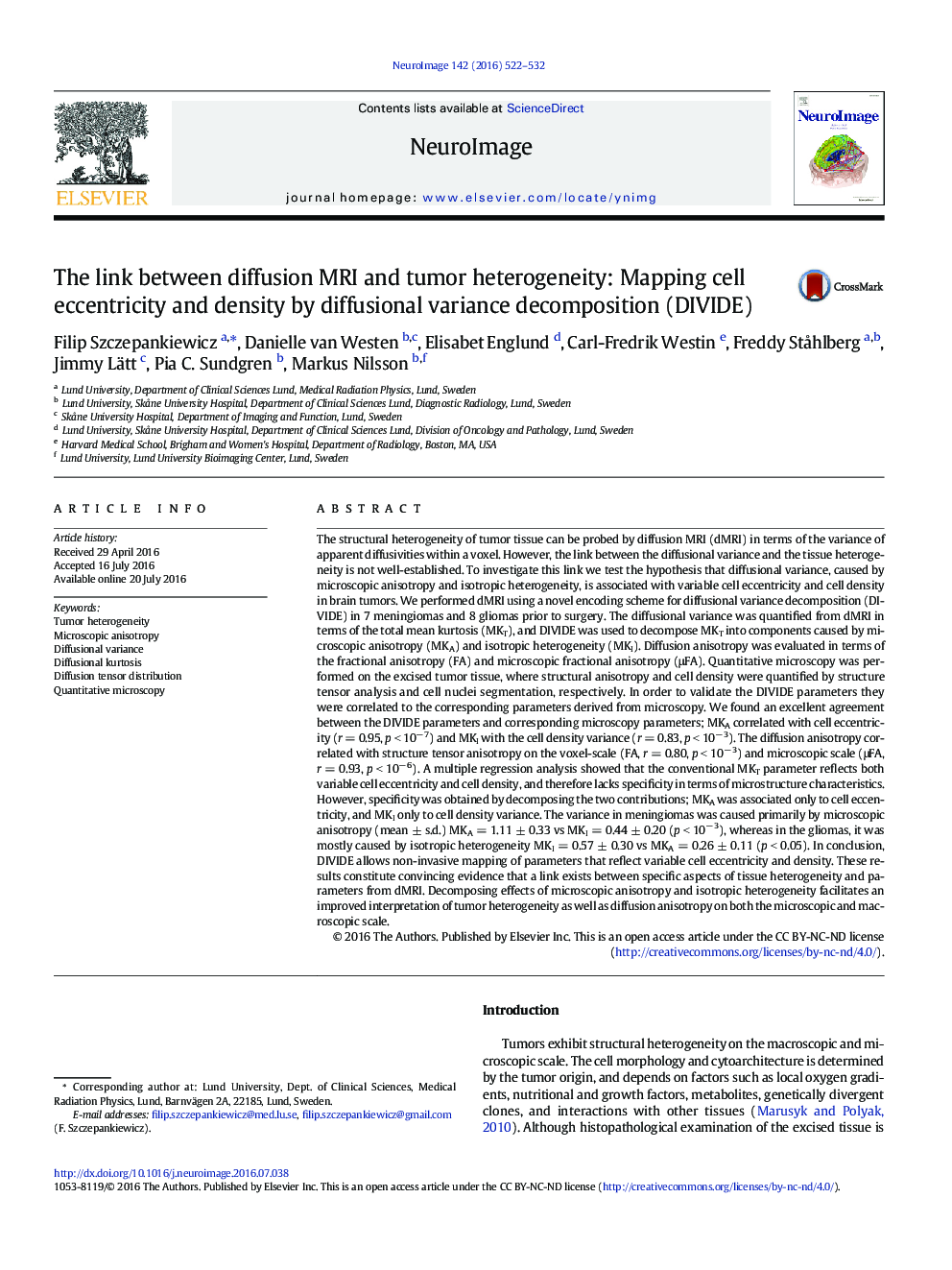| کد مقاله | کد نشریه | سال انتشار | مقاله انگلیسی | نسخه تمام متن |
|---|---|---|---|---|
| 5631457 | 1580866 | 2016 | 11 صفحه PDF | دانلود رایگان |

- Tumor heterogeneity was investigated by diffusion MRI and quantitative microscopy.
- Diffusional variance was decomposed into micro-anisotropy and isotropic heterogeneity.
- Quantitative microscopy yielded cell eccentricity and density in the excised tumors.
- An excellent correlation was found between diffusion and microscopy parameters.
- The source of tumor heterogeneity can be probed by diffusional variance decomposition.
The structural heterogeneity of tumor tissue can be probed by diffusion MRI (dMRI) in terms of the variance of apparent diffusivities within a voxel. However, the link between the diffusional variance and the tissue heterogeneity is not well-established. To investigate this link we test the hypothesis that diffusional variance, caused by microscopic anisotropy and isotropic heterogeneity, is associated with variable cell eccentricity and cell density in brain tumors. We performed dMRI using a novel encoding scheme for diffusional variance decomposition (DIVIDE) in 7 meningiomas and 8 gliomas prior to surgery. The diffusional variance was quantified from dMRI in terms of the total mean kurtosis (MKT), and DIVIDE was used to decompose MKT into components caused by microscopic anisotropy (MKA) and isotropic heterogeneity (MKI). Diffusion anisotropy was evaluated in terms of the fractional anisotropy (FA) and microscopic fractional anisotropy (μFA). Quantitative microscopy was performed on the excised tumor tissue, where structural anisotropy and cell density were quantified by structure tensor analysis and cell nuclei segmentation, respectively. In order to validate the DIVIDE parameters they were correlated to the corresponding parameters derived from microscopy. We found an excellent agreement between the DIVIDE parameters and corresponding microscopy parameters; MKA correlated with cell eccentricity (r = 0.95, p < 10â 7) and MKI with the cell density variance (r = 0.83, p < 10â 3). The diffusion anisotropy correlated with structure tensor anisotropy on the voxel-scale (FA, r = 0.80, p < 10â 3) and microscopic scale (μFA, r = 0.93, p < 10â 6). A multiple regression analysis showed that the conventional MKT parameter reflects both variable cell eccentricity and cell density, and therefore lacks specificity in terms of microstructure characteristics. However, specificity was obtained by decomposing the two contributions; MKA was associated only to cell eccentricity, and MKI only to cell density variance. The variance in meningiomas was caused primarily by microscopic anisotropy (mean ± s.d.) MKA = 1.11 ± 0.33 vs MKI = 0.44 ± 0.20 (p < 10â 3), whereas in the gliomas, it was mostly caused by isotropic heterogeneity MKI = 0.57 ± 0.30 vs MKA = 0.26 ± 0.11 (p < 0.05). In conclusion, DIVIDE allows non-invasive mapping of parameters that reflect variable cell eccentricity and density. These results constitute convincing evidence that a link exists between specific aspects of tissue heterogeneity and parameters from dMRI. Decomposing effects of microscopic anisotropy and isotropic heterogeneity facilitates an improved interpretation of tumor heterogeneity as well as diffusion anisotropy on both the microscopic and macroscopic scale.
416
Journal: NeuroImage - Volume 142, 15 November 2016, Pages 522-532